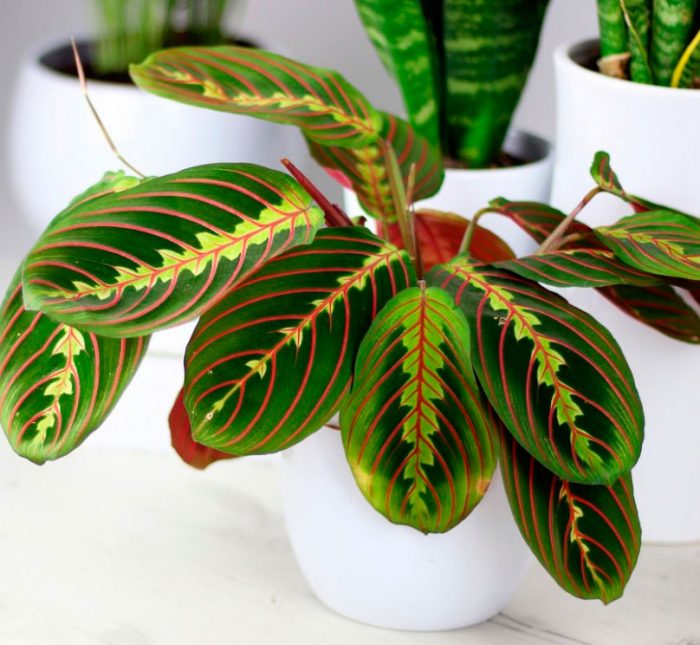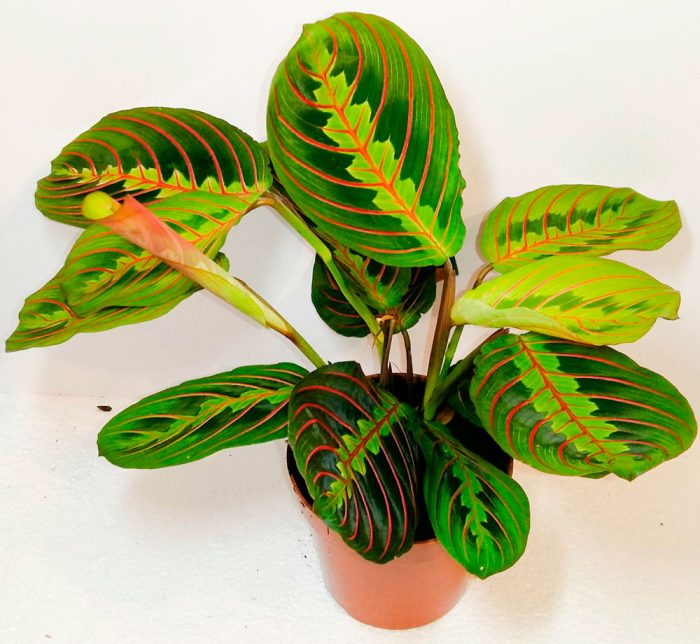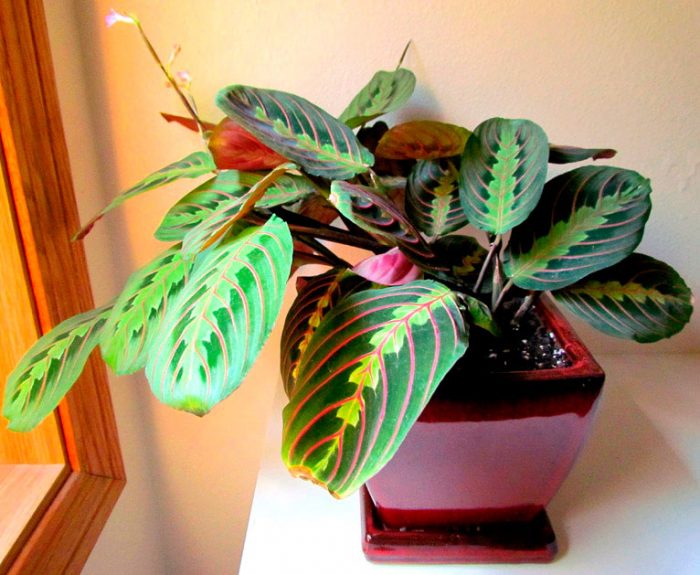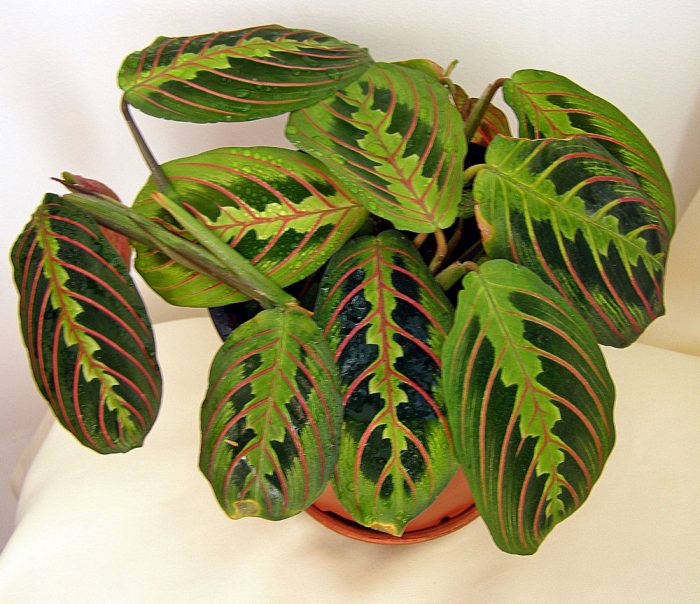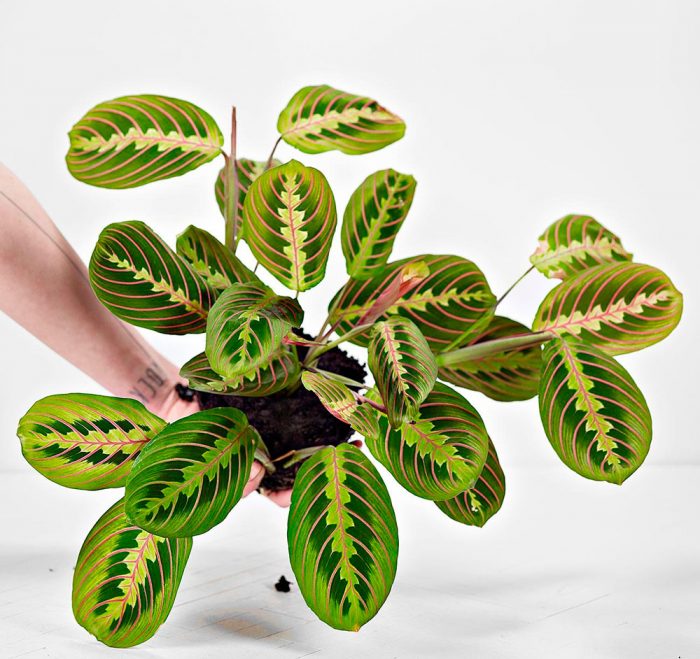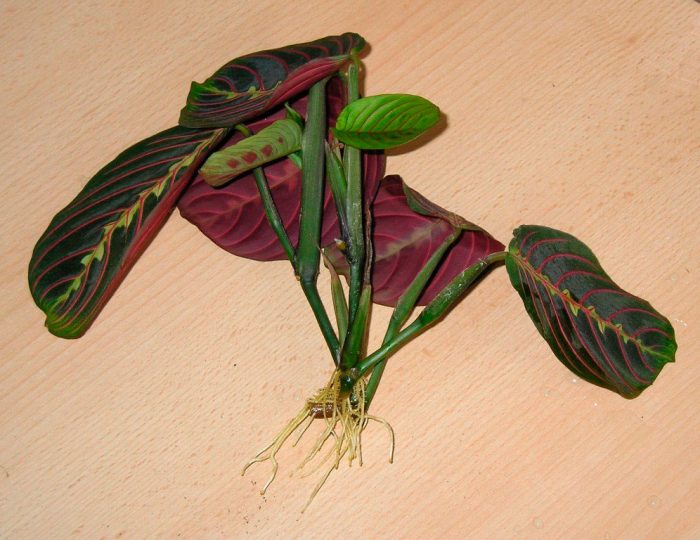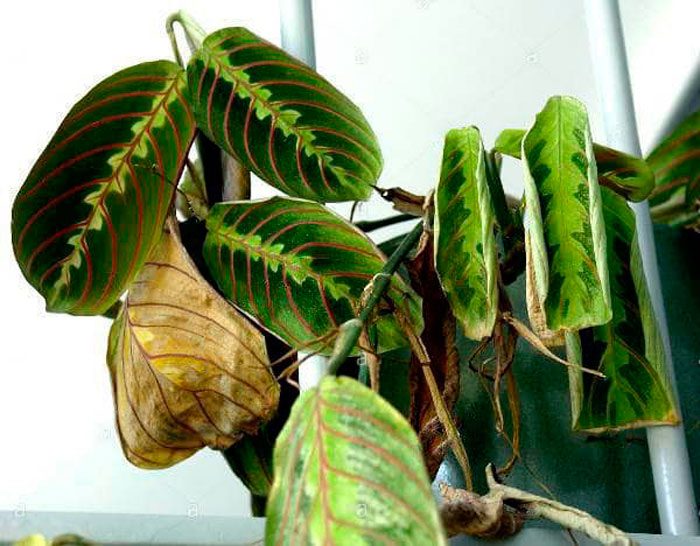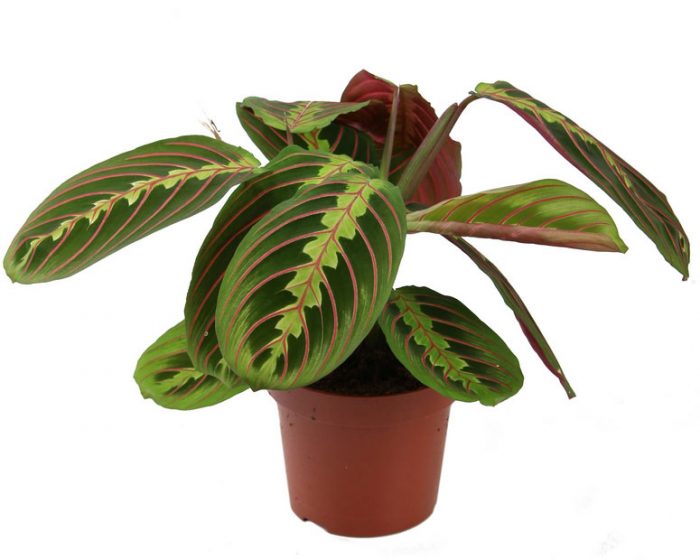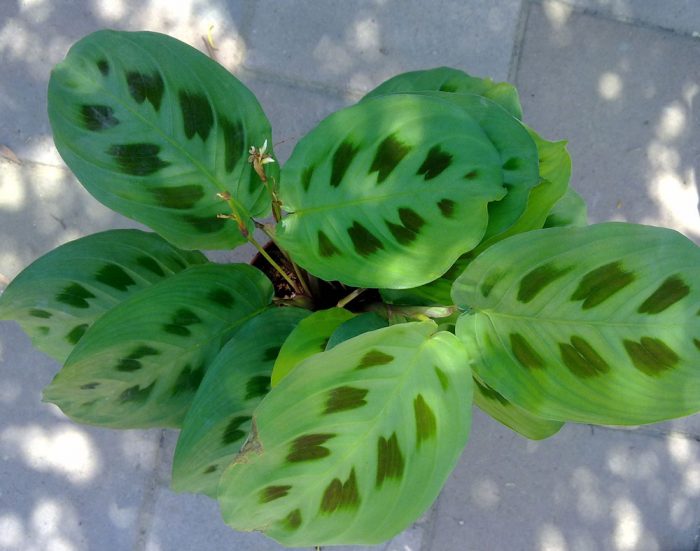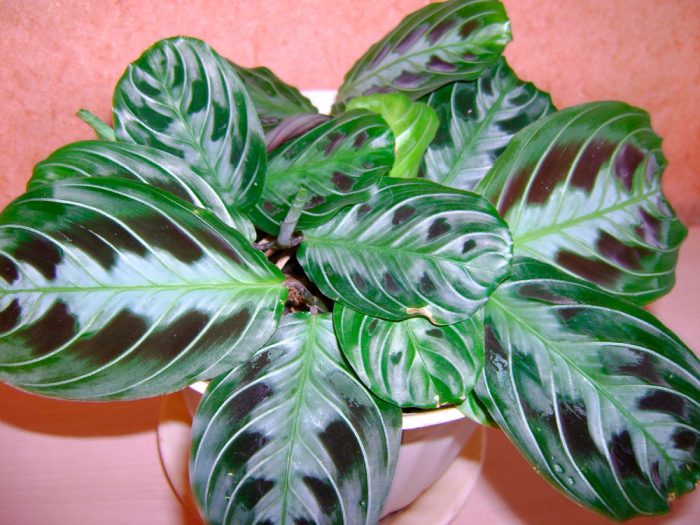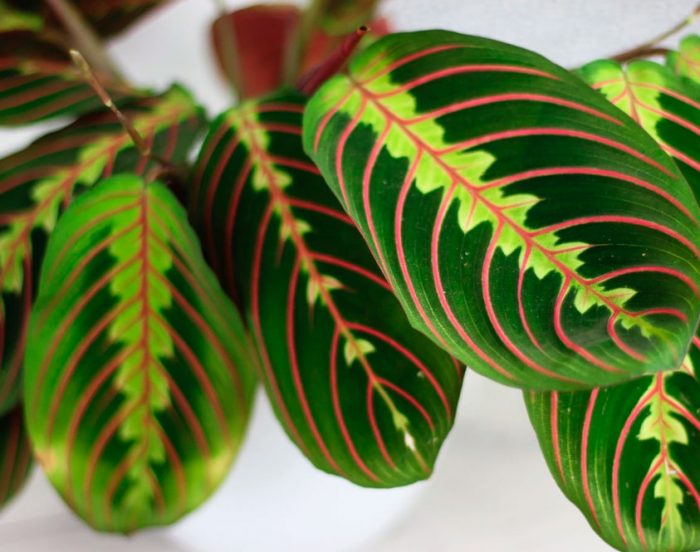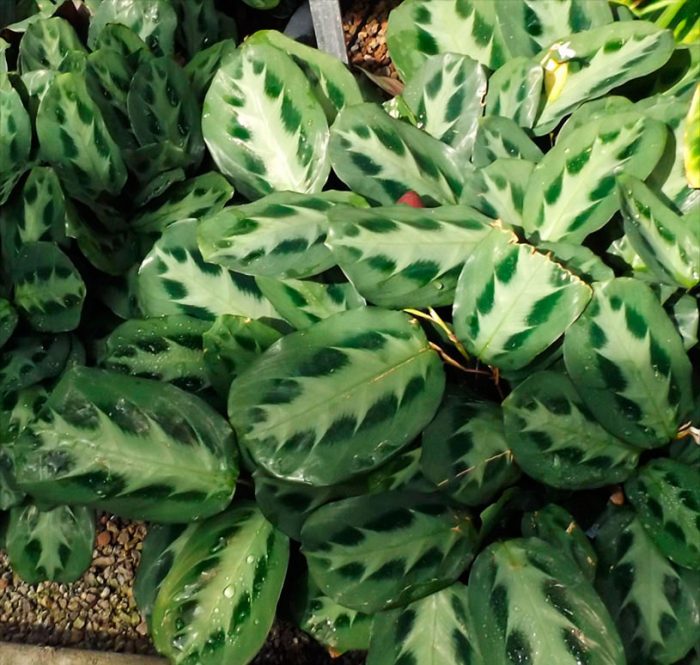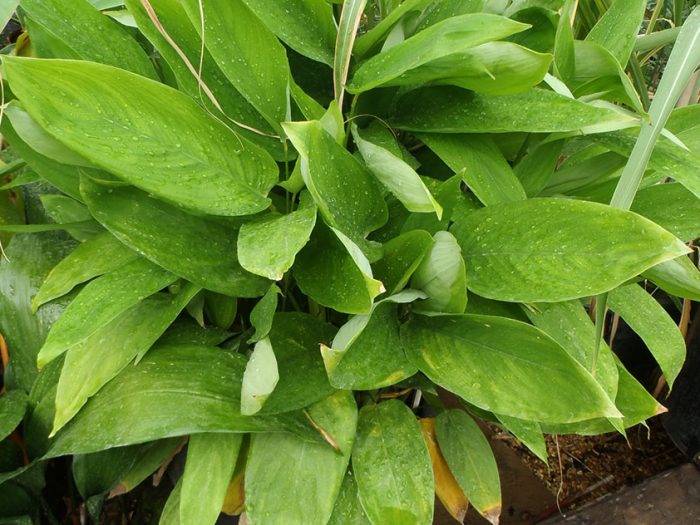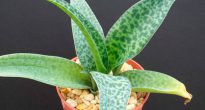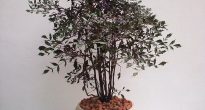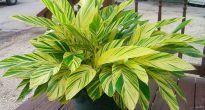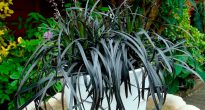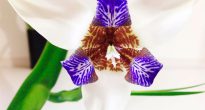The arrowroot plant (Maranta) is part of the arrowroot family, this genus unites about 25 species. It was named after a physician from Venice, Bartalomeo Maranta. In nature, the plant can be found in Central and South America, but it prefers to grow in forests in swampy areas. Most often, arrowroot is cultivated as an ornamental-deciduous plant, the shape of its foliage can vary from oval-round to linear-lanceolate, as a rule, it is painted green, and on its surface there is a pattern that can have a different color and shape. When grown indoors, the plant practically does not bloom, and if it does bloom, then small white flowers appear on it. Arrowroot tricolor, also called a prayer plant, was named so because of the foliage, the fact is that under bad conditions it rises up, and under good conditions it is placed horizontally. In some species of arrowroot, the roots are used to make flour, it is used for dietary nutrition. It is believed that this flower is able to protect the home from negative energy, reduce excessive excitement and prevent arguments, quarrels and scandals between households.
Content
Brief description of cultivation
- Bloom... Arrowroot is grown as an ornamental deciduous plant.
- Illumination... Needs a lot of light to be diffused. You can also grow a flower under artificial light, but in this case, the duration of daylight hours should be 16 hours.
- Temperature regime... In the summer period - from 23 to 25 degrees, and the temperature of the soil mixture in the pot should be at least 18 degrees. From the second half of autumn to the last spring weeks - from 18 to 20 degrees.
- Watering... In the spring-summer period, water should be plentifully, immediately after the top layer of the soil mixture dries out. In the cold season, watering should be moderate.
- Air humidity... Should be elevated. Throughout the year, the bush is moistened with lukewarm water from a spray bottle. To increase the humidity, wet expanded clay is poured into the pallet, and a flower pot is placed on it.
- Fertilizer... Top dressing is carried out throughout the year 1 time in 15 days, for this, organic matter and mineral fertilizers are alternately used in half the dosage.
- Dormant period... Not pronounced.
- Transfer... The procedure is carried out every 2 years in the first spring weeks.
- Soil mixture... It should consist of garden soil, sand and peat (6: 2: 3).
- Reproduction... Dividing the bush and cuttings.
- Harmful insects... Spider mites.
- Diseases... The plant can lose its decorative effect in unsuitable conditions for it or due to improper care.
Arrowroot care at home
Illumination
Arrowroot needs bright, but diffused light, it must be protected from direct rays of the sun. Therefore, it is recommended to place it on an east or west orientation window. If the direct rays of the sun regularly fall on the flower, then adult leaf plates can lose their spectacular color, and young ones become smaller. If you cannot find a place for a flower with optimal lighting, then it is recommended to grow it under fluorescent lamps, while the duration of daylight hours in this case should be at least 16 hours.
Temperature regime
Such a flower can be harmed by both excessively high and low air temperatures. In summer, make sure that the air temperature is from 23 to 25 degrees, while do not allow the substrate in the pot to overcool (at least 18 degrees). From mid-autumn to early summer, the optimum air temperature for arrowroot is 18–20 degrees. It can withstand a temperature drop of up to 10 degrees, but if it is colder, the plant will die. Protect him from sudden changes in temperature during the day, as well as from drafts.
Watering
During the spring-summer period, watering should be abundant, while making sure that water does not stagnate in the substrate, but the clod of earth should not be allowed to dry out. In the cold season, watering is moderate, it is carried out immediately after the surface of the soil mixture in the pot dries out. For watering, you need to use warm water, the temperature of which should be slightly higher than room temperature, because the root system reacts extremely negatively to hypothermia. It should also be soft and well-settled (at least 12 hours).
Air humidity
The flower needs high air humidity, in this regard, it is moistened with settled soft water from a sprayer throughout the year. If the humidity level is very low, then spraying should be carried out regularly in the morning and evening. And to increase the humidity, the container with the flower is placed on a pallet, which is filled with wet expanded clay or pebbles, while making sure that the bottom of the pot does not come into contact with the liquid. In the warm season, the plant can be given a warm shower, while remember that the substrate in the pot must be covered with a film so that no water gets into it during the procedure. However, be prepared for the fact that even if all these conditions are met, the tops of the leaf plates will dry on the arrowroot.
Fertilizer
Top dressing is carried out systematically 1 time in 2 weeks, for this, organic matter and mineral fertilizers are used alternately (the concentration of the nutrient mixture should be 2–3 times less than recommended by the manufacturer).
Transplanting arrowroot
The transplant is carried out once every 2 years in the first spring weeks. The planting capacity is taken low and it is better if it is plastic, while in size it should be slightly larger than the old one. At the bottom, a drainage layer is made of coarse sand and broken brick (expanded clay). The substrate needs a slightly acidic one. It can include peat, sand and garden soil (3: 2: 6) or peat, humus and leafy soil (1: 1: 1). It is recommended to add a small amount of charcoal and coniferous soil to the finished soil mixture.
Before proceeding with the transplant, you need to cut off all the dried and sluggish foliage from the bush, in this case, young shoots will develop more actively.


Watch this video on YouTube
Reproduction methods
Reproduction by division
You can propagate arrowroot by dividing the rhizome.This procedure is recommended to be carried out in conjunction with a transplant. To get started, remove an adult plant from the pot and divide it into 2 or 3 parts, while trying not to injure the root system. Delenki are planted in separate pots filled with peat. Young bushes are watered regularly immediately after the surface of the soil mixture in the container dries out. The container with the divider is placed in a plastic bag, which is not tied very tightly. Keep it warm until young leaf plates appear.
Cuttings
Cuttings are harvested in May-June, for this they cut off a part of the young shoot, on which there should be 2 or 3 leaf plates. To root the segments, use a jar filled with clean water, the roots should appear after 4-6 weeks. The rooted cutting is planted in a peat-based soil mixture and provides it with the best possible care.
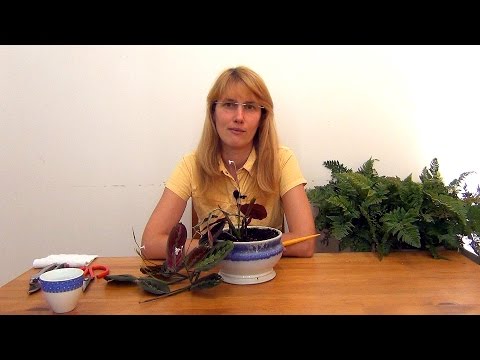

Watch this video on YouTube
Possible problems
If the arrowroot is improperly looked after or if you do not provide it with suitable conditions, then problems can begin with it:
- The tips of the leaves dry out. If the air in the room is too dry, then the tops of the foliage turn brown and dry out, they even sometimes fall off. Also, due to low humidity, the growth of the bush may become slower.
- Rot has appeared... If in winter the plant is watered excessively or it will be in the cold, then its shoots may lose turgor, and rot may form on them.
- Spots on foliage... If the flower feels a lack of moisture, then specks form on its leaf plates, they begin to roll up, and yellowing of the lower foliage is also observed.
- The bush becomes faded... The plant reacts extremely negatively to direct sunlight, because of this, the leaves lose their spectacular color and dry out.
- Harmful insects... The greatest danger to him is represented by spider mites.
Types of arrowroot with photos and names
Arrowroot (Maranta leuconeura)
Under natural conditions, the plant can be found in the tropics, or rather, in the humid forests of Brazil. It has a tuberous root, and the length of the stem can reach about 0.3 m. The petioles of the foliage reach no more than 20 mm in length. The width of the leaf plate is about 9 centimeters, and the length is up to 15 centimeters, they have a rounded elliptical shape, while at the base it is heart-shaped. Their front surface is dark green, decorated with a pale green pattern and white veins, the seamy surface is greenish-blue or pale red. The following varieties of this species are most popular with flower growers: Kerchovena (kerchoveana), Masange (massangeana), tricolor (tricolor) or red-veined (leuconeura):
Maranta kerchoveana
The height of such a herbaceous perennial plant is about 25 centimeters. Short petiolate oval leaf plates are about 15 centimeters long. There are many dark green specks on the upper rich green surface of the plate, and a white stripe runs along the median vein. The seamy surface of the plate has a color that can go from light blue to pale red. White flowers are collected in inflorescences 2-3 pieces.
Maranta massangeana
The plant is very similar to the Kerhoven variety (see above), but its foliage is decorated with brownish olive specks.
Arrowroot tricolor (tricolor) (Maranta tricolor)
The length of the oval pubescent leaf plates is about 13 centimeters, and the width is up to 6 centimeters. The color of the front surface of the plates can vary from dark green to greenish, it is decorated with red veins and pale green specks along the median vein, and along the lateral veins there are dark green feather-shaped spots. The seamy surface is crimson with streaks of pink color. The flowers are painted in pale lilac color.
Arrowroot bicolor (Maranta bicolor)
This species does not form tubers. Oval short-peaked leaf plates have a slightly wavy edge, their length is about 15 centimeters. On the front surface of the green plate along the median vein, there are brown spots, and on the seamy side there are hairs, and it is painted in a pale red color.
Arrowroot (Maranta arundinacea)
This species is represented by a shrub whose height is slightly more than 100 cm. Its roots are thick and tuberous. The length of the ovoid leaf plates is about 25 centimeters, they have a slight sharpening in the upper part. The seamy surface is covered with hairs and has a dark green color. The flowers are white.
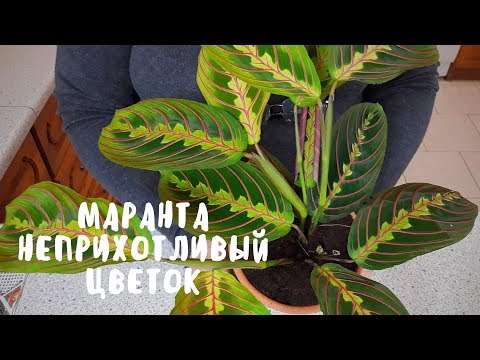

Watch this video on YouTube

